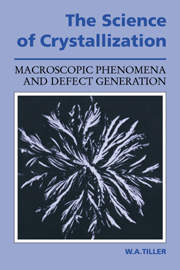Book contents
- Frontmatter
- Contents
- Preface
- Symbols
- 1 Introduction
- 2 Convection and heat transfer
- 3 Steady state solute partitioning
- 4 Macroscopic and microscopic solute redistribution
- 5 Morphological stability of interfaces
- 6 Dynamic interface morphologies
- 7 Physical defect generation during bulk crystal growth
- 8 Defect generation during thin film formation
- References
- Index
6 - Dynamic interface morphologies
Published online by Cambridge University Press: 22 January 2010
- Frontmatter
- Contents
- Preface
- Symbols
- 1 Introduction
- 2 Convection and heat transfer
- 3 Steady state solute partitioning
- 4 Macroscopic and microscopic solute redistribution
- 5 Morphological stability of interfaces
- 6 Dynamic interface morphologies
- 7 Physical defect generation during bulk crystal growth
- 8 Defect generation during thin film formation
- References
- Index
Summary
In this chapter, we utilize the basic concepts and some of the earlier quantitative results to predict and understand many of the morphological feature developments that are found in crystals and films. We begin with macroledge development in both films and crystals.
Layer flow instabilities
For vicinal surface orientations, although the growth conditions are not such as to produce the massive instability characterized by Eq. (5.13a), a range of less severe growth conditions exist wherein instabilities can develop in the layer front flowing across the crystal surface at Vℓ ≫ V. Thus, instead of the layer front being straight and smooth or faceted, it is rumpled with edge waves that are growing in amplitude as the front proceeds. This is just the two-dimensional analog of the instabilities already discussed (see Fig. 5.21). Like its three-dimensional counterpart, microsegregation events and microdefects are built into the growing crystal when such layer flow instabilities develop and the quantitative assessment of the onset of these instabilities is important to the growth of high quality crystals.
There are two types of perturbation consequences that interest us here: (1) that giving rise to a ledge density instability leading to ledge bunching and the growth of h/a as indicated in Fig. 6.1(b) and (2) that giving rise to ledge front instability of the lateral kind as indicated in Fig. 6.1(c).
- Type
- Chapter
- Information
- The Science of CrystallizationMacroscopic Phenomena and Defect Generation, pp. 283 - 364Publisher: Cambridge University PressPrint publication year: 1992

